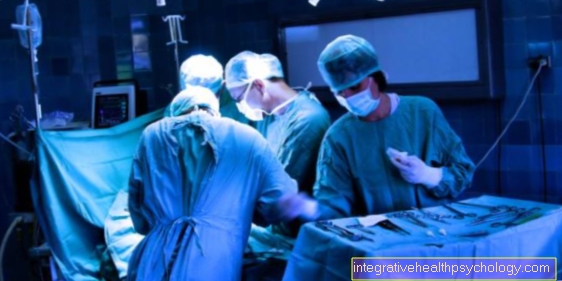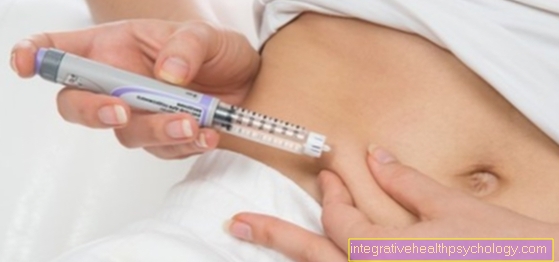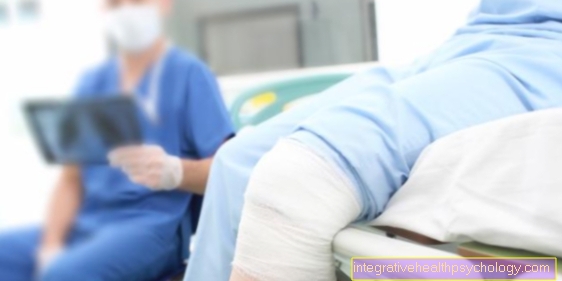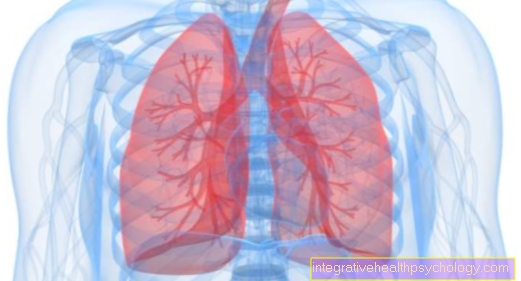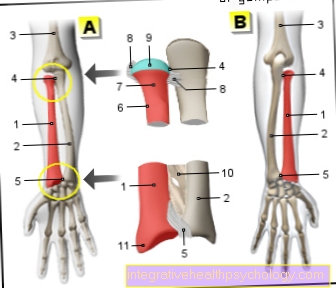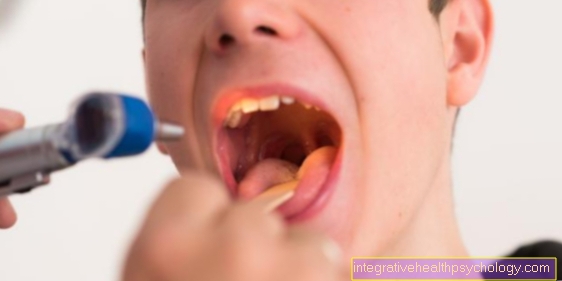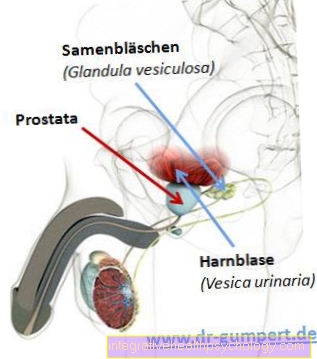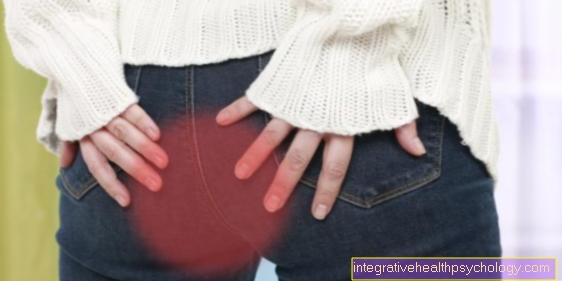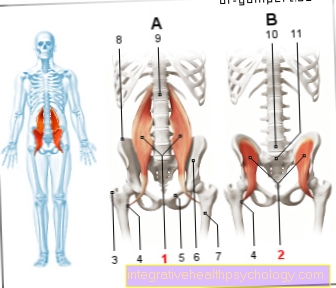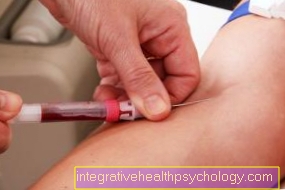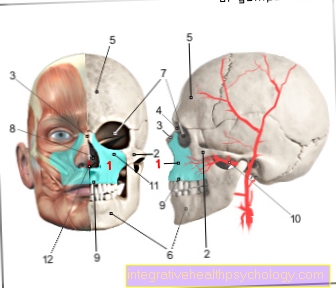Inflammation on the dental implant
What is peri-implantitis?
Peri-implantitis is a disease of the gums around a dental implant. Without treatment, this inflammation can deepen the area of the dental implant and thus destroy the bone. In the early stages, this disease is called mucositis, i.e. a gum disease that can subside on its own. Later on, the disease irreversibly destroys the implant bone and, without treatment, causes the implant to be lost.
Also read: Peri-implantits

causes
The causes of peri-implantitis are diverse, with several factors usually playing a certain role at the same time. The development is comparable to the development of periodontitis (periodontal disease), since the cause here is also the increased formation of plaque. Inadmissible oral hygiene causes bacteria and plaque to settle at the gum junction and can cause inflammation there. This inflammation grows together with the concretions (solid, calcified plaque) like on a natural tooth in the direction of the tooth bone and triggers its regression.
Furthermore, there are some risk factors that can cause and exacerbate peri-implantitis. These include, for example, smoking, through which the body's self-healing powers are damaged, thieves, periodontitis occurring at the same time on healthy teeth, various medications, hormonal changes or persistent stress. However, the most important factor is oral hygiene. If this is carried out regularly and checked by the dentist, the peri-implantitis cannot spread as much or not develop in the first place.
Also read the article on the topic: Risks of a dental implant
diagnosis
The dentist makes the diagnosis of peri-implantitis using several diagnostic methods. By looking at the implant and the surrounding gums, inflammation can be seen at first glance. The dentist receives information about the already advanced bone decline by scanning the bone with a special instrument (the PA probe), which can be a little painful during treatment and by checking whether the implant is already wobbling. In addition, an X-ray can be made to determine the exact size of the decline.
What can you see on the x-ray?
A funnel-shaped bone loss can be seen on the right and left of the implant on the X-ray. While in a healthy implant the bone on the right and left should be approximately at the level of the last turn of the implant or even a little higher and flush with the implant, a bone collapse can be seen in a diseased implant. Several turns of the implant are exposed and only the last few millimeters remain firmly in the bone.
frequency
According to recent studies, peri-implantitis affects about 30% of all implant patients. Since peri-implantitis is a disease of the tooth bone and can be roughly equated with periodontitis (inflammation of the dental bed on the "real" tooth), patients suffer from similar symptoms.
This also means that the risk of periimlantitis is increased if the patient is already suffering from periodontitis. Oral hygiene is therefore the most important point in preventing this disease. Proper, regular cleaning and checking by the dentist can keep the implants healthy in the long term.
Find out more about the topic: Periodontal disease
These symptoms could indicate inflammation on the dental implant
While there is only a slight inflammation of the gums at the beginning, the symptoms can increase sharply in the later stages. Initially, the inflammation triggers slight pain when touching the surrounding tissue and can be recognized by reddening. As the inflammation spreads, the gums retreat, as in periodontal disease, it begins to bleed and there is more pain when the dental implant is loaded.
In the worst case, the whole implant will loosen and move while chewing. This can also lead to the formation of pus, with the pus being secreted into the oral cavity via the gingival pocket.
Pain
The dental implant itself cannot cause pain as it is not a living part of the body. Rather, it is the gums and the bone in which the implant is located that trigger the pain. The gums redden and swell when inflamed and can therefore hurt and bleed very badly when touched.
However, if the pain does not arise in the gums but in the bone, this is a sign that the bone is being remodeled or broken down. If the bone resorption is very advanced, the implant moves and pus and pain develop when chewing.
Find out more about the topic: Shelf life of dental implants
pus
The formation of pus occurs in the advanced stage of peri-implantitis, when the implant bone is already severely reduced and bacteria can multiply unhindered in the gingival pockets. Usually the pus formation occurs together with loosening of the implant. While loose teeth can often be strengthened again with the right treatment, the prognosis for implants is much worse.
Treatment as soon as possible is essential to prevent implant loss.
Find out more about the topic: Remove the dental implant
therapy
The aim of the therapy is to reduce the bacterial load in order to heal the inflammation of the bone and gums. Various treatment methods are available for this. At the beginning of the disease, rinsing solutions and professional teeth cleaning with tooth / implant pocket cleaning often help to get the gingivitis under control. In addition, ointments are available to accelerate this process.
In the case of deeper inflammations, laser treatment can disinfect the gingival pocket even more intensely. The locally used laser kills bacteria and stops further tissue breakdown. If the disease is advanced, additional surgery is inevitable to prevent the loss of the implant. The gums are cut open around the implant and the implant turns are exposed. In this way, the dentist can clean all concretions and plaque from the implant and then insert a bone substitute material into the wound to stabilize the bone. Then the wound is sutured and the implant can grow back firmly to the bone. As a prophylaxis for long-term therapy, regular implant checks by the dentist are recommended, as well as regular professional cleaning of the dental implants and teeth.
You might also be interested in this topic: Proper care of a dental implant
These antibiotics are used
When treating peri-implantitis, different antibiotics are used depending on the number and severity of the implants affected. In the case of severe illness, the dentist will administer the antibiotic in tablet form; amoxicillin in particular has become established in dentistry.
In the case of a penicillin allergy, the substitute antibitotic clindamycin can also help. If the inflammation is less severe, local antibiosis is often sufficient. Here an antibiotic ointment (Ligosan) is injected into the inflamed gum pocket on several consecutive days and can spread its effect there.
Duration
The duration of peri-implantitis treatment is lifelong, as is the case with periodontitis, as the disease is triggered by the proliferation of harmful bacteria, which are part of the standard flora of the oral cavity. In therapy and through hygiene, attempts are made to avoid the extreme reproduction of these bacteria.
The acute treatment consists of several short sessions in which the affected areas are first cleaned and rinsed and then checked several times and medicated with an ointment. In the long-term course of the disease, perfect oral hygiene with teeth cleaning several times a year is necessary in order to keep the risk of the disease flaring up again as low as possible.
Also read the article on the topic: Periodontal Treatment
costs
Periimplatitis treatment is a service that is not covered by statutory health insurance and must therefore be paid for in full by the person concerned. Only a few private health insurance companies bear the costs for this disease.
Depending on the dentist, the cost of cleaning is around € 200, but in the case of severe bone resection it is around € 500, since bone augmentation is also necessary here. In addition, there are the costs for the antibiotic ointment and possibly follow-up interventions if the disease cannot be remedied by the first intervention.
Recommendations from the editorial team
- Dental implant
- Peri-implantitis
- Shelf life of dental implants
- Remove the dental implant
- Professional tooth cleaning
- Prophylaxis of periodontal disease

